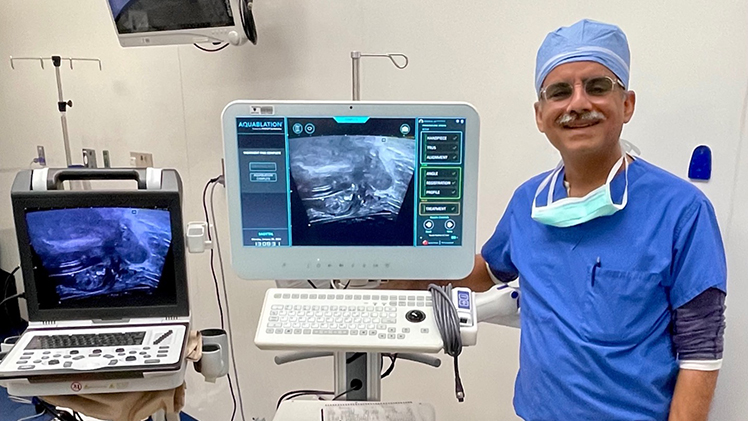The University of Toledo Medical Center has added a new, minimally invasive treatment option for enlarged prostate that uses high-pressure water to relieve urinary symptoms while preserving sexual function.
UTMC is the first in Toledo and one of the first academic medical centers in the state to offer the therapy, called Aquablation.

Dr. Puneet Sindhwani, chair of the UTMC Department of Urology and Kenneth Kropp Endowed Professor of Urology at The University of Toledo College of Medicine and Life Sciences.
By combining a heat-free water jet with robotic guidance and precise, image-guided mapping, physicians can remove enlarged prostate tissue with a much lower risk of damaging nearby structures and nerves.
“This is a huge step forward,” said Dr. Puneet Sindhwani, chair of the UTMC Department of Urology and Kenneth Kropp Endowed Professor of Urology at The University of Toledo College of Medicine and Life Sciences. “By eliminating heat, lasers and electricity, there’s less chance for complications and by using robotics, it takes away human error. It’s a very, very precise treatment and can be tailored to the needs of an individual patient.”
Enlarged prostate, also known as benign prostatic hyperplasia or BPH, is extremely common. By age 60, roughly half of all men have some degree of BPH. That jumps to up to 90% of men older than 80.
Though BPH is unrelated to prostate cancer, it can cause significant urinary symptoms. Common complaints include difficulty urinating, frequent urges to urinate — particularly at night — and an inability to fully empty the bladder.
“This is a condition of aging, but we are seeing more and more younger men suffering from BPH symptoms as well,” Sindhwani said. “It’s a major quality of life issue. That’s where these kinds of precise treatments make all the difference.”
Medication is usually the first-line treatment for enlarged prostate and for many men it is enough; however, not all men respond well to medication, particularly those with very large prostates. Medication can also lose effectiveness over time, and some men may experience significant side effects such as muscle weakness and drops in blood pressure that can lead to fainting.
There are a variety of minimally invasive surgical procedures to treat BPH, but most rely on some form of heat generated by lasers or electricity to destroy prostate tissue, raising the possibility of scarring or thermal damage to other structures. That, Sindhwani said, is a major concern for men who are concerned about losing sexual function. Data cited by Prospect BioRobotics, the company that makes the Aquablation device, show more than 80% of men aren’t willing to sacrifice sexual function for symptom relief.
Clinical studies have found nearly 100% of sexually active men retain their ability to achieve an erection after the Aquablation procedure, and approximately 90% retain their ability to ejaculate.
“Some patients who needed removal of enlarged prostate through the abdomen can now be treated with this lesser invasive technique,” Sindhwani said. “This decreases the need for a longer hospital stay, blood transfusions and risk of incontinence of urine.”
The procedure is typically done under general anesthesia, with the surgeon accessing the prostate through the urethra. Most patients will spend one night in the hospital and will have fully recovered within a couple of weeks.
The procedure is covered by most major insurers, including Medicare.
For more information or to schedule an appointment with a UTMC urologist, call 419.383.3578 or 419.473.3446 for the Regency Medical Campus office.